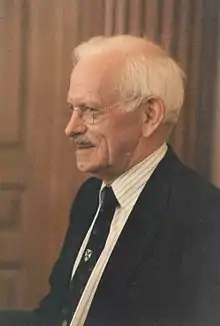George John Romanes (anatomist)
Born in Edinburgh in 1916, George John Romanes was educated at the Edinburgh Academy, the University of Cambridge, and the University of Edinburgh.[1]
George John Romanes | |
|---|---|
 Romanes in 1984 | |
| Born | 2 December 1916 Edinburgh |
| Died | 9 April 2014 Isle of Skye |
| Nationality | Scottish |
| Occupation | Professor of Anatomy |
| Awards | C.B.E, F.R.S.Ed., B.A., Ph.D., M.B., ChB., D.Sc.(h.c.), F.R.C.S.Ed., F.R.S.E., H.R.S.A. |
| Academic background | |
Career
At Cambridge, Romanes read for the Natural Sciences Tripos, graduating with a B.A. in 1938. In 1941, he returned to Edinburgh to finish the clinical part of his medical course and graduated M.B., Ch.B. in 1944. He then returned to Cambridge for two years, as a Beit Memorial Fellow for Medical Research. In 1942, he completed a Ph.D. in Anatomy during the tenure of a Marmaduke Shield Scholarship (1938–40), and a Demonstratorship in Anatomy. In 1946, Romanes was appointed Lecturer in Neuro-anatomy in Edinburgh and spent 1949–50 in the Department of Neurology in Columbia University, New York funded by a Commonwealth Fund Fellowship. In 1954, he succeeded J.C. Brash as Professor of Anatomy to become the twelfth holder of the chair since its institution in 1705. He retired in 1984, having spent 45 years as a member of the University's staff.
Publications
George's published papers show that the large neurons in the spinal cord that supply individual muscles are clustered together in discrete, nuclei-termed pools that are arranged according to the position of the limb muscles they are programmed to innervate. Furthermore, in a now-classic paper published in 1951, Romanes showed that the pools of motor neurons innervating the muscles that act together to control a limb joint are themselves grouped together into larger clusters – thus uncovering a remarkable positional registration between a motor neuron and its target muscle. Romanes reasoned that “all the higher parts of the central nervous system would be organized in a similar, basic way," a premise that is now gathering experimental support.[2] His contemporaries used his maps to identify the pathognomonic lesions of motoneurones seen in the polio epidemic that was sweeping the United States of America. Modern workers using transgenic mice have confirmed the genetically-determined location of the motor neurone pools and shown the rest of the spinal cord network, including the connection of the sensory nerves, to be dependent on the positional template first described by Romanes.[3]
References
- "Professor George Romanes: Acclaimed medical scholar whose teaching". The Independent. 17 April 2014.
- Romanes, George J. (1951). "The motor cell columns of the lumbo-sacral spinal cord of the cat". The Journal of Comparative Neurology. 94 (2): 313–363. doi:10.1002/cne.900940209. ISSN 1096-9861. PMID 14832391.
- Jessell, Thomas M.; Sürmeli, Gülşen; Kelly, John S. (2011). "Motor Neurons and the Sense of Place". Neuron. 72 (3): 419–424. doi:10.1016/j.neuron.2011.10.021. PMID 22078502.